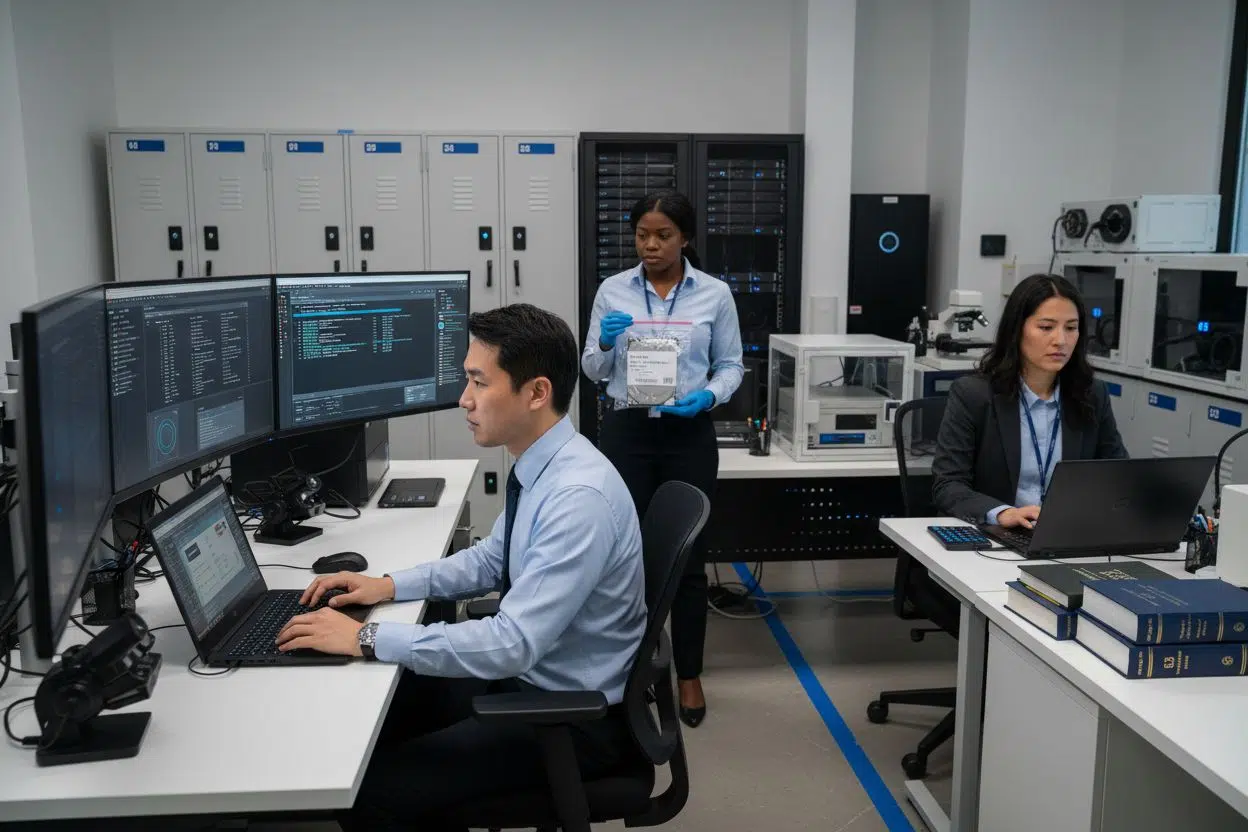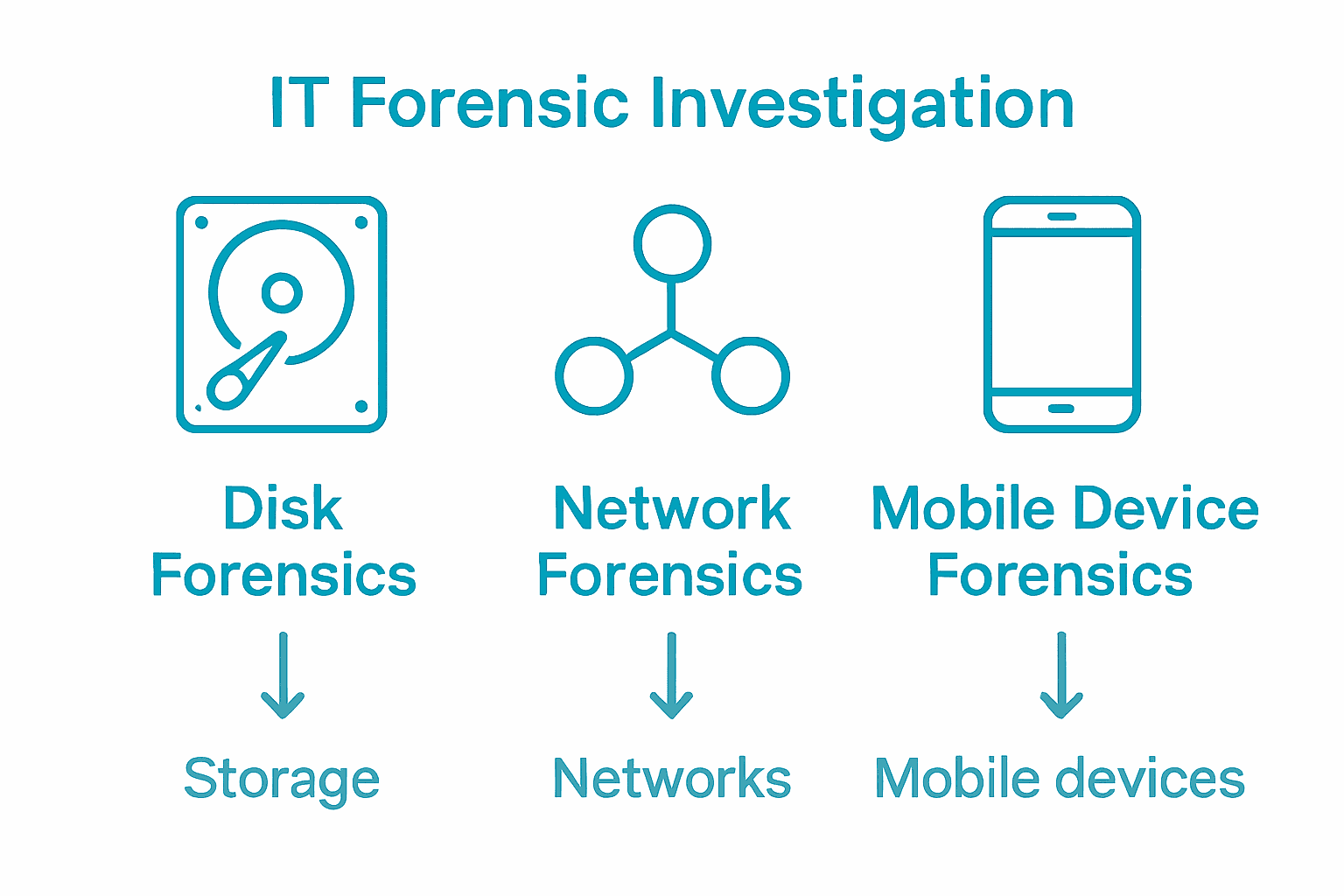Nearly 70 percent of organisations have faced a cyber incident requiring digital investigation within the past year. As our lives and businesses move further online, digital footprints can make or break crucial legal cases and business decisions. Understanding how IT forensic services work sheds light on the technology and expertise driving modern investigations, helping unravel hidden evidence and support justice in an increasingly digital world.
Key Takeaways
| Point | Details |
|---|---|
| Role of IT Forensic Services | IT forensic services merge technology and legal expertise to recover and analyze digital evidence for legal cases and investigations. |
| Types of Investigations | Various types of IT forensic investigations, such as disk forensics and network forensics, address specific digital environments and challenges. |
| Technological Tools | Forensic experts utilize advanced technologies like packet sniffers and data recovery software to extract and analyze digital evidence effectively. |
| Legal Compliance | Adherence to stringent legal and procedural standards is critical to ensuring the integrity and admissibility of digital evidence in court. |
Table of Contents
- Defining IT Forensic Services And Their Role
- Types Of IT Forensic Investigations Explained
- Key Technologies Used In IT Forensics
- Legal And Regulatory Requirements In Digital Forensics
- Common Scenarios: Corporate, Legal, And Private Cases
- Risks, Challenges, And Best Practice Recommendations
Defining IT Forensic Services and Their Role
IT forensic services represent a sophisticated intersection of technology, legal expertise, and investigative techniques designed to recover, analyse, and protect digital evidence across various contexts. According to research from leading technology education institutions, these services combine law and computer science to systematically collect and analyse data from computer systems, networks, and digital storage devices in a manner that ensures legal admissibility.
Digital forensic investigators operate like digital detectives, meticulously collaborating to solve complex technological mysteries. As research from academic sources indicates, these professionals use specialized equipment to identify, capture, and critically analyse cyber evidence. Their work involves retrieving potentially erased data, examining user accounts, and adapting swiftly to rapidly evolving technological landscapes.
Key responsibilities of IT forensic services include:
- Retrieving and preserving digital evidence without compromising its integrity
- Documenting precise data locations and digital footprints
- Assisting legal teams in civil and criminal proceedings
- Investigating potential cybercrime, data breaches, and digital misconduct
- Providing expert testimony and comprehensive forensic reports
These services play a crucial role in modern investigations, bridging technological complexity with legal requirements and helping organisations and law enforcement uncover critical digital insights.
Types of IT Forensic Investigations Explained
Cyber forensics encompasses a diverse range of investigative techniques designed to extract, analyse, and preserve digital evidence across multiple technological platforms. According to research from technology experts, these investigations span several critical domains, each targeting specific digital environments and technological challenges.
According to digital forensics investigations research, the primary types of IT forensic investigations include:
Here’s a summary of the primary types of IT forensic investigations:
| Investigation Type | Focus Area | Typical Use Case |
|---|---|---|
| Disk Forensics | Storage devices | Recover deleted files |
| Network Forensics | Network traffic | Trace security breaches |
| Mobile Device Forensics | Smartphones & tablets | Analyse mobile communications |
| Database Forensics | Database systems | Investigate data manipulation |
| Memory Forensics | Volatile computer memory | Detect hidden processes/malware |
| Cloud Forensics | Online cloud environments | Examine remotely stored evidence |
| Malware Forensics | Malicious software analysis | Understand malware origin/impact |
- Disk Forensics: Recovering and analysing data from storage devices, uncovering deleted or hidden information
- Network Forensics: Monitoring and investigating network traffic to trace digital interactions and potential security breaches
- Mobile Device Forensics: Extracting and examining data from smartphones, tablets, and other portable digital devices
- Database Forensics: Investigating database systems to uncover manipulated or unauthorized data modifications
- Memory Forensics: Analysing volatile computer memory to detect running processes, malware, and hidden system activities
- Cloud Forensics: Investigating digital evidence stored in cloud computing environments
- Malware Forensics: Examining malicious software to understand its origin, functionality, and potential impact
These specialised investigation types require advanced technical skills, allowing forensic experts to meticulously reconstruct digital events, support legal proceedings, and protect organisations from technological threats.
Key Technologies Used in IT Forensics
Digital forensic technologies represent a sophisticated arsenal of tools and techniques designed to extract, analyse, and preserve critical digital evidence across complex technological landscapes. According to research, these technologies span multiple investigative approaches, enabling forensic experts to uncover hidden insights and reconstruct digital events with remarkable precision.
Forensic investigators employ two primary investigative methodologies: digital forensic techniques encompassing both dead-box forensics (examining powered-off devices) and live forensics (analysing volatile data in active systems). The technological toolkit includes:
- Packet Sniffers: Capturing and analysing network traffic
- Intrusion Detection Systems: Monitoring and identifying potential security breaches
- Data Recovery Software: Retrieving deleted or hidden digital information
- Forensic Analysis Platforms: Comprehensive tools for systematic digital investigation
- Memory Analysis Tools: Examining volatile system memory for hidden processes
- Disk Imaging Technologies: Creating exact digital replicas of storage devices
- Cryptographic Analysis Tools: Decrypting and examining encrypted data
These advanced technologies enable forensic professionals to meticulously reconstruct digital events, provide critical evidence for legal proceedings, and uncover complex technological mysteries with unprecedented accuracy.
Legal and Regulatory Requirements in Digital Forensics
Digital forensics operates at the critical intersection of technological investigation and legal compliance, requiring meticulous adherence to strict scientific and judicial standards. According to research from law enforcement and technology experts, these investigations demand precise methodological approaches to ensure the integrity and admissibility of electronic evidence in legal proceedings.
The core legal framework for digital forensics in litigation encompasses several fundamental requirements:
- Chain of Custody: Documenting and preserving the complete history of digital evidence
- Evidence Integrity: Maintaining the original state of digital artifacts without contamination
- Scientific Methodology: Applying reproducible, validated investigative techniques
- Procedural Transparency: Detailing every step of the forensic investigation
- Legal Admissibility: Ensuring evidence meets court-approved standards of collection and analysis
- Data Privacy Compliance: Protecting individual rights during digital investigations
- Technological Neutrality: Using unbiased, court-acceptable forensic tools and methods
Forensic investigators must continuously adapt to evolving technological landscapes while maintaining rigorous legal standards, ensuring that digital evidence can effectively support judicial processes and provide credible insights into complex digital interactions.
Common Scenarios: Corporate, Legal, and Private Cases
Digital forensic investigations span a complex landscape of scenarios, addressing critical challenges across corporate, legal, and private domains. Research indicates that these investigations are not confined to a single context but represent a versatile approach to uncovering digital truth in diverse situations.
According to computer forensic services research, the primary investigation scenarios include:
- Corporate Misconduct: Investigating employee fraud, intellectual property theft, and unauthorized data breaches
- Criminal Investigations: Assisting law enforcement in tracking digital evidence related to cybercrime, financial fraud, and criminal activities
- Civil Litigation: Supporting legal proceedings by recovering and analysing digital evidence for divorce cases, employment disputes, and contractual conflicts
- Internal Corporate Audits: Examining digital records to ensure compliance and detect potential regulatory violations
- Intellectual Property Disputes: Tracing the origins of proprietary information and documenting potential infringements
- Personal Privacy Cases: Investigating digital harassment, online stalking, or unauthorized access to personal digital assets
- Data Recovery for Individual Clients: Retrieving lost or deleted personal and professional digital information
These scenarios demonstrate the critical role of digital forensics in providing objective, scientifically validated insights across multiple domains, helping organisations and individuals navigate complex digital landscapes with precision and legal integrity.
Risks, Challenges, and Best Practice Recommendations
Digital forensic investigations present a complex landscape of technological and methodological challenges that demand sophisticated approaches and continuous adaptation. The rapidly evolving digital environment requires forensic professionals to develop robust strategies for maintaining investigative integrity and effectiveness.
According to digital forensic techniques research, key risks and challenges in the field include:
- Data Volume Complexity: Managing and analysing massive amounts of digital information
- Technological Volatility: Keeping pace with rapidly changing digital technologies and potential evidence preservation techniques
- Evidence Preservation: Maintaining forensic data integrity without compromising original digital artifacts
- Tool Diversity: Navigating multiple forensic tools with varying capabilities and potential limitations
- Legal and Ethical Constraints: Ensuring investigations comply with strict legal and privacy regulations
- Ephemeral Evidence: Capturing and documenting transient digital traces before they disappear
- Cross-Platform Compatibility: Developing investigation approaches that work across diverse technological ecosystems
Proactive best practices involve continuous professional development, investing in advanced forensic technologies, maintaining rigorous documentation protocols, and developing adaptable investigative methodologies that can respond to emerging digital challenges with precision and scientific objectivity.
Gain Clarity and Control Over Your Digital Evidence Challenges
When urgent questions arise about cybercrime, data breaches, or internal misconduct, the risk of overlooked digital evidence becomes a real concern. Complex investigations require trustworthy expertise to recover lost data, analyse forensic traces, and maintain proper chain of custody at every stage. If you are seeking answers in any of the ten key areas where IT forensic services offer critical support, our team at Computer Forensics Lab is ready to help. We understand how vital it is to act quickly and accurately to secure digital proof and deliver clear, expert witness reports.
Do not leave your case or security exposed by uncertain processes. Visit our Digital Forensics solutions for a closer look at how we can support your investigation and legal needs. If chain of custody and evidence handling are priorities, our Chain of Custody Tracking resources provide insight into how we safeguard your digital data every step of the way. Take control of complex challenges now and discover comprehensive answers at Computer Forensics Lab.
Frequently Asked Questions
What are IT forensic services?
IT forensic services involve using technology, legal expertise, and investigative techniques to recover, analyze, and protect digital evidence from computer systems and networks, ensuring legal admissibility.
What types of investigations do IT forensic services conduct?
IT forensic services conduct various types of investigations including disk forensics, network forensics, mobile device forensics, database forensics, and malware forensics, each targeting specific digital environments and challenges.
How do IT forensic services ensure the integrity of digital evidence?
They ensure evidence integrity by following strict protocols for chain of custody, maintaining evidence in its original state, and applying validated scientific methodologies during the collection and analysis process.
What are common scenarios in which IT forensic services are utilized?
Common scenarios include investigating corporate misconduct, assisting in criminal investigations, supporting civil litigation, conducting internal corporate audits, and addressing personal privacy cases.


